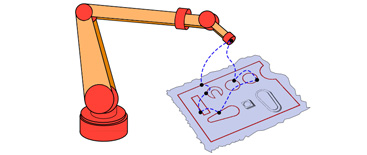Robot Trajectory Optimization for Relaxed Effective Tasks (optiPlan)
 Industrial robots are flexible machines that are currently involved in multiple production domains. The typical workflow if an industrial robot consists of two alternating stages: effective and supporting.
Industrial robots are flexible machines that are currently involved in multiple production domains. The typical workflow if an industrial robot consists of two alternating stages: effective and supporting.
The first stage is effective movements that are required to perform a task, e.g., welding a seam or cutting a whole. The second stage is supporting movements that are needed to move from one effective task to another, e.g., movements between welding seams or between cuttings. The current trend in industrial robot programming is to program both movements based on the programmer intuition. Due to this, often a certain way of performing an effective task is chosen, with no regard to robot kinematics. However, at the same time, many effective tasks allow a certain freedom during their execution, e.g., the robot’s tool might have a certain deviation during welding. This freedom can be used as an extra degree of freedom for robot trajectory optimization. In this project, we develop a formalization of this freedom for effective tasks. We refer to an effective task with a formalized freedom of execution as a relaxed effective task. Having an infinite number of ways to execute a task raises several research questions:
- How to optimize a sequence of entry points for relaxed effective tasks?
Our answer: to model this problem as a Traveling Salesman Problem with Neighborhoods (TSPN). We propose two heuristics to solve TSPN. Further details. - How to find starting robot configurations for these tasks?
Our answer: represent the problem as a set of nested search domains. Further details. - How to optimize a robot trajectory for a certain relaxed task?
- How to optimize a sequence of entry points for relaxed effective tasks?
